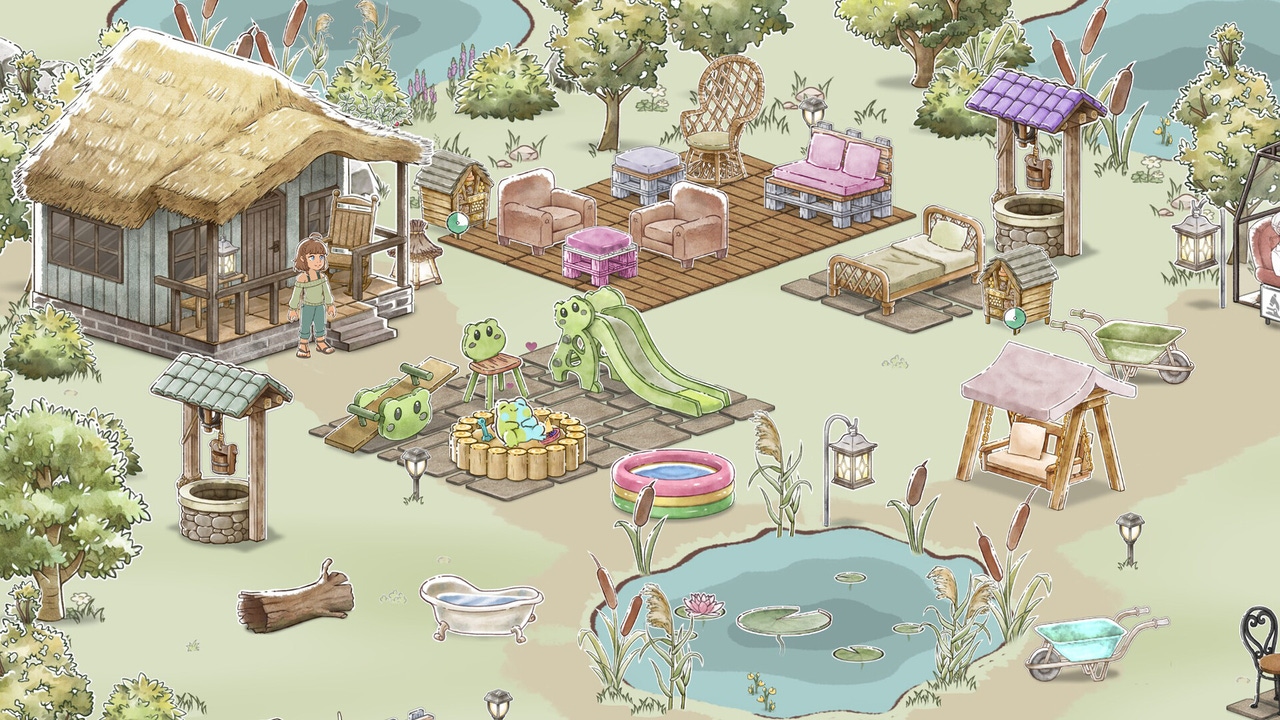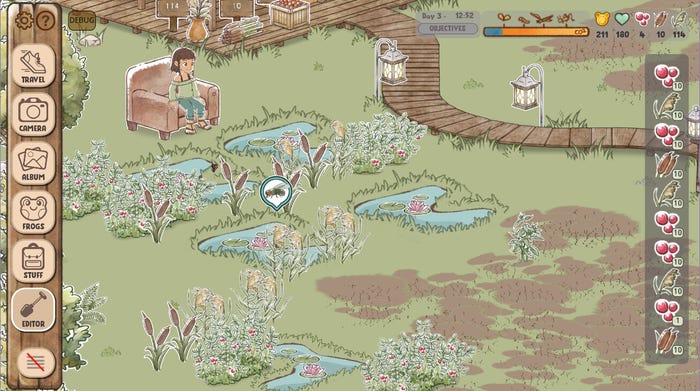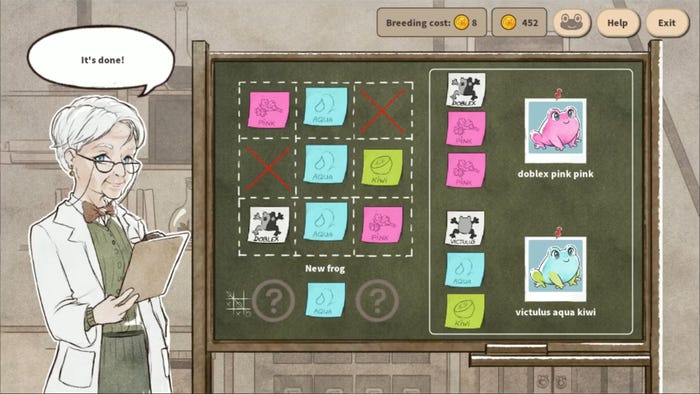Trending
Opinion: How will Project 2025 impact game developers?
The Heritage Foundation's manifesto for the possible next administration could do great harm to many, including large portions of the game development community.
The developers at Humble Reeds talk about how they wove conservationism into the game's mechanics without bogging the them down in the complexities of environmental care.

Kamaeru: A Frog Refuge lets players collect all sorts of adorable frogs, taking pictures of them as they explore a variety of habitats. While a delightful experience purely from spending time with the frogs alone, there is an underlying theme of wetland importance and care that makes this game so much more than a cute animal collection.
Game Developer caught up with Mélanie Christin and Aurélien Condomines of Humble Reeds to talk about how they came up with the idea of collecting frogs to increase awareness of wetland importance and preservation, the challenges that come from making many different cute frogs players would want to collect, and how they wove wetland preservation into the game’s mechanics without bogging the game down in the complexities of environmental care.
Game Developer: What inspired the creation of a game about collecting frogs and restoring wetlands? How did the concept for Kamaeru: A Frog Refuge come together?
Mélanie Christin and Aurélien Condomines: We both had a desire to make games with a positive societal impact that were still fun to play. While researching tangible solutions about climate change on the Project Drawdown website, we read about how wetlands are natural carbon sinks and just how much carbon would be captured or not emitted if we committed to preserving and restoring wetlands. This seemed to be a very concrete solution, and wetlands are rich places.
To encourage players to care about wetlands and their biodiversity, we made frogs the main object of care because they’re popular and the most likely to be tended to as pets. So that’s how two main pillars of the game came to be: restoring the wetlands so that your pet frogs are happy!
There is also an important decoration aspect in the game, as well as some narrative parts, because we think the audience for Kamaeru is interested in these features in a game. The storyline binds all these elements together by enabling the game progression and traveling to new biomes.

Image via Armor Games Studios.
What thoughts went into weaving wetland care together with frog collecting? How did you maintain a balance so that the joys of collecting cute frogs were always at the forefront, but a strong message about restoring biodiversity was still threaded throughout the game?
As we said, frogs are the vehicle that make players care even more about wetlands, so it was necessary that the two aspects were closely intertwined. In the game, you cannot progress without restoring the wetlands: they have a carbon capture gauge and a biodiversity score, and you need those two for the frog collecting aspect both because rare frogs will only show in restored wetlands but also for collecting insects that you feed your frogs with.
The same is true the other way around: you need the reputation points that your frog refuge generates to unlock more effective wetland restoration tools. This way, the two aspects are carefully balanced and complementary. We do not try to impose an eco-friendly message on players; we follow the rule “show, don’t tell.” The wetlands are restored and beautiful, and the cute frogs are happy.
What ideas went into creating so many different types of cute frogs for players to collect? How did you develop such a variety of fun frogs for players to find?
A lot of people ask us if the frogs’ species are based on real-life frogs, but unlike most of the rest in the game, the answer is no. With the collecting aspect, and with a video game with a lot of tiny elements, you need the patterns to be very distinctive from each other so that you immediately know if it’s already part of your collection or not. And because we want the game to be fun and appealing, we needed big, recognizable, cute frogs that pop on the screen and catch the players’ attention. We thus had to invent fantasy patterns for the frogs that would be easily recognizable and combine them with a certain number of colors to have a wide range of possible frogs while maintaining a certain level of readability. Right now, the full game contains eight patterns of frogs, with eight possible colors for primary and secondary colors, which puts the frog count at 512.
LIkewise, how did you decide on the various biomes and places across the world where players would collect their frogs?
We wanted the different biomes to be quite distinctive from each other, from the color palette to the different types of native vegetation you would find. We also thought it would be fun for players all around the world to discover other types of biomes than the ones they know and meet all sorts of local characters. Luckily there are tons of different wetlands around the globe!
The first biome is kind of a Western peatland that you would find, for example, in the northern parts of Germany. The second biome is a Billabong, a certain type of Australian wetland based on dead river arms that flood in winter and get dry in the summer. The third one is an Indonesian mangrove located near the coastline, with trees and vegetation adapted to a mix of saline and sweet water.
Each is restored differently, but they all contribute to carbon capture in their own way and need to be preserved.
Can you tell us a bit about the research that went into the game? How did you learn about wetlands and other environmental elements and how those shaped the development of Kamaeru: A Frog Refuge?
The game remains a game; it is not an educational game on frogs or wetlands, so we did some research, but not at a scientific level. The frogs being fantasy frogs helped a lot in this aspect!

Images via Armor Games Studios.
What thoughts went into picking the ways that players would interact with those biomes in order to draw frogs to them? How did you design a variety of different environmental activities players would take part in to teach them about biodiversity while making them light enough that the game would not get bogged down in complex ideas?
We kept the environmental activities really light and drew inspiration from common city-building games where you just place elements along a grid and watch them interact. The biodiversity part was trickier: we wanted players to restore a wetland, but not by just planting a ton of the same crop. We had to account for the balance between the crops and convey that to the players in the most simple way. So, we came up with what we call a “Bioscore,” which is how biodiversity influences your carbon capture to come up with a unified score. If one of the crops is lagging behind, we nudge the player to plant more of it through a simple set of icons in the wetland dashboard.
Then there are more optional environmental activities, like picking up nettle to make powder, installing beehives and insect hotels, etc. But they’re not as crucial as the biodiversity aspect.
Your environmentally conscious message is carefully run through not just the game, but how you developed it to be lightweight and work on older computers as well. Can you tell us what appealed to you about creating a game that would work on a wider variety of computer specs? What challenges did you face as creators in getting Kamaeru: A Frog Refuge to be able to work on more machines?
We are developing the game with Godot Engine, which is naturally built for lightweightness and performance on low-tier machines. It also allows us to target a lot of platforms all at once, thanks to the thousands of open-source contributors working together to achieve that.
Because the game is in the cozy genre, one of our biggest goals was to port the game to the Nintendo Switch, which has specs that do not compare well with high-end PCs, so we were mindful in each of our design decisions that it didn’t impact performance too much.
We are also quite a small team, with a small budget, strong 2D expertise, and developing the game on our own old-ish computers, so all of that makes us savvy in every way!
What effect do you hope your game has on the player? What thoughts do you hope your game inspires?
As is probably the case for every game developer out there, we would be glad if we could bring joy to as many players as possible. More specifically, Kamaeru is designed to make players feel good and relaxed after a long day, bringing them some peace to their busy minds. We hope that through the story, they feel reinvigorated about working together with others for the greater good, and that they see how beautiful wetlands can be. And maybe—and that would be the cherry on the cake—build a small pond in their yard or contribute to local wetlands or biodiversity initiatives!
You May Also Like